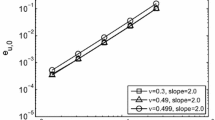Summary
A new mixed finite element formulation for the equations of linear elasticity is considered. In the formulation the variables approximated are the displacement, the unsymmetric stress tensor and the rotation. The rotation act as a Lagrange multiplier introduced in order to enforce the symmetry of the stress tensor. Based on this formulation a new family of both two-and three-dimensional mixed methods is defined. Optimal error estimates, which are valid uniformly with respect to the Poisson ratio, are derived. Finally, a new postprocessing scheme for improving the displacement is introduced and analyzed.
Similar content being viewed by others
References
Amara, M., Thomas, J.M.: Equilibrium finite elements for the linear elastic problem. Numer. Math.33, 367–383 (1979)
Arnold, D.N., Douglas, J., Gupta, C.P.: A family of higher order mixed finite element methods for plane elasticity. Numer. Math.45, 1–22 (1984)
Arnold, D.N., Brezzi, F.: Mixed and nonconforming finite element methods: implementation, postprocessing and error estimates. RAIRO Math. Mod. Anal. Numer.19, 7–32 (1985)
Arnold, D.N., Brezzi, F., Douglas, J.: PEERS: A new finite element for plane elasticity. Jap. J. Appl. Math.1, 347–367 (1984)
Arnold, D.N., Falk, R.S.: Well-posedness of the fundamental boundary value problems for constrained anisotropic elastic materials. Arch. Rat. Mech. Anal.98, 143–167 (1987)
Babuška, I., Osborn, J., Pitkäranta, J.: Analysis of mixed methods using mesh dependent norms. Math. Comput.35, 1039–1062 (1980)
Bercovier, M.: Perturbation of mixed variational problems: Application to mixed finite element methods. RAIRO Anal. Numer.12, 211–236 (1978)
Boland, J.M., Nicolaides, R. A.: Stability of finite elements under divergence constraints. SIAM J. Num. Anal.20, 722–731 (1983)
Brezzi, F.: On the existence, uniqueness and approximation of saddle-point problems arising from Lagrangian multipliers. RAIRO Ser. Rouge8, 129–151 (1974)
Brezzi, F., Douglas, J., Marini, L.D.: Two families of mixed finite element methods for second order elliptic problems. Numer. Math.47, 217–235 (1985)
Brezzi, F., Douglas, J., Marini, L.D.: Recent results on mixed finite element methods for second order elliptic problems. In: Vistas in Applied Mathematics. Numerical Analysis, Atmospheric Sciences and Immunology. pp. 25–43. Heidelberg Berlin New York: Springer 1986
Ciarlet, P.G.: The finite element method for elliptic problems.. Amsterdam: North-Holland 1978
Crouzeix, M., Raviart, P.A.: Conforming and nonconforming finite elements for solving the stationary Stokes equations. RAIRO Ser. Rouge7, 33–76 (1973)
Fraijs de Veubeke, B.X.: Displacement and equilibrium models in the finite element method. Stress Analysis. (O.C. Zienkiewicz, G. Holister, eds.), pp. 145–197. New York: Wiley 1965
Fraijs de Veubeke, B.X.: Stress function approach. Bournemouth, World Conference in Finite Elements 1975 pp. J.1–J.51
Johnson, C., Mercier, B.: Some equilibrium finite element methods for two-dimensional elasticity problems. Numer. Math.30, 103–116 (1978)
Karp, S.N., Karal, F.C.: The elastic field in the neighbouthood of a crack of arbitrary angle. CPAM15, 413–421 (1962)
Mansfield, L.: On mixed finite element methods for elliptic equations. Comput. Math. Appl.7, 59–66 (1981)
Mirza, F.A., Olson, M.D.: The mixed finite element method in plane elasticity. Int. J. Numer. Methods Eng.15, 273–290 (1980)
Nedelec, J.C.: Mixed finite elements inR 3. Numer. Math.35, 315–341 (1980)
Raviart, P.A., Thomas, J.M.: A mixed finite element method for 2nd order elliptic problems. Proceedings of the Symposium on the mathematical aspects on the finite element method. Lecture Notes in Mathematics No.606, 292–315. Berlin Heidelberg New York: Springer 1977
Pitkäranta, J., Stenberg, R.: Analysis of some mixed finite element methods for plane elasticity equations. Math. Comput.41, 399–423 (1983)
Stenberg, R.: Analysis of mixed finite element methods for the Stokes problem: A unified approach. Math. Comput.42, 9–23 (1984)
Stenberg, R.: On the construction of optimal mixed finite element methods for the linear elasticity problem. Numer. Math.48, 447–462 (1986)
Stenberg, R.: On the postprocessing of mixed equilibrium finite element methods. In: Numerical techniques in continuum mechanics. Proceedings of the Second GAMM-Seminar, Kiel 1986. (W. Hackbusch, K. Witsch, ed.), pp. 102–109. Braunschweig: Vieweg 1987
Williams, M.L.: Stress singularities resulting from various boundary conditions in angular plates in extension. J. Appl. Mech.19, 526–528 (1952)
Zienkiewicz, O.C., Li, X.-K., Nakazawa S.: Iterative solution of mixed problems and the stress recovery procedures. Comm. Appl. Numer. Methods3, 3–9 (1985)
Author information
Authors and Affiliations
Rights and permissions
About this article
Cite this article
Stenberg, R. A family of mixed finite elements for the elasticity problem. Numer. Math. 53, 513–538 (1988). https://doi.org/10.1007/BF01397550
Received:
Issue Date:
DOI: https://doi.org/10.1007/BF01397550




